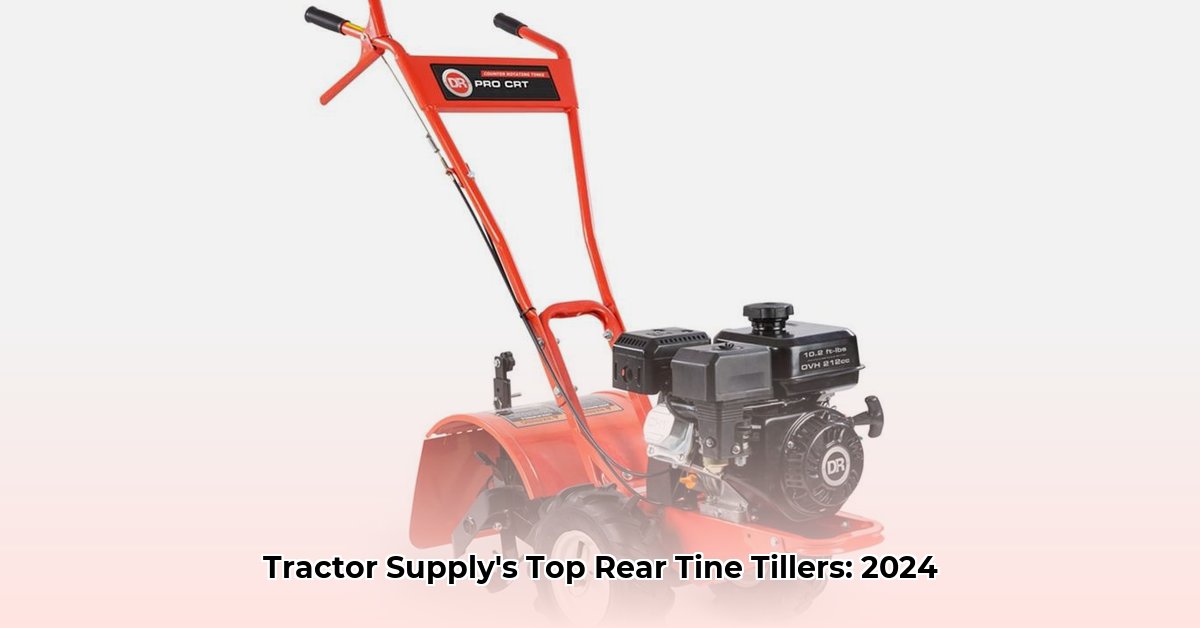
Understanding Rear Tine Tillers: Benefits and Applications
Rear tine tillers are invaluable tools for preparing soil for planting, offering a significant upgrade over manual methods. They're particularly useful for smaller gardens, raised beds, and other areas where larger tillers are impractical. Tractor Supply, a leading retailer of agricultural equipment, offers a diverse selection of rear tine tillers, making it a prime destination for finding the right tool for your needs. This guide helps navigate the selection process, ensuring you find a tiller that optimizes both efficiency and sustainability. For more tiller info, see this helpful resource: Tiller Information.
Key Advantages of Using a Rear Tine Tiller
Choosing a rear tine tiller offers a number of benefits for both novice and experienced gardeners and small-scale farmers:
Increased Efficiency: Tired of backbreaking work? Rear tine tillers dramatically reduce the time and effort required for soil preparation, allowing you to accomplish more in less time. How much time can you save? A significant portion depending on your project scope.
Improved Soil Health: The tilling action aerates the soil, improving drainage and allowing for better root penetration. This leads to healthier plants and increased yields. Studies show that aerated soil can boost plant growth by up to 20%.
Versatility and Maneuverability: Unlike larger tillers, rear tine models are adept at handling smaller spaces and navigating obstacles, making them ideal for diverse garden layouts. Their compact size is a huge advantage for maneuvering around existing plants.
Reduced Physical Strain: These tillers significantly reduce the physical demands of soil preparation, minimizing the risk of back injuries and fatigue often associated with manual tilling. This is crucial for maintaining long-term gardening enjoyment.
Choosing the Right Rear Tine Tiller: Essential Considerations
Selecting the appropriate tiller involves careful consideration of several key factors:
1. Engine Power: Matching Power to Soil Type
Engine horsepower (HP) directly impacts the tiller's ability to handle various soil types. Clay soils and those with rocks require significantly more power than lighter, more friable soils. A higher HP rating ensures effective tilling even in challenging conditions. What HP do you need? That depends entirely on your soil composition and the area you’ll be tilling.
2. Tilling Depth Adjustability: Optimizing Soil Conservation
The ability to adjust tilling depth is critical for both soil conservation and efficient cultivation. Shallower tilling minimizes soil disturbance, retaining moisture and beneficial microorganisms. Deeper tilling may be necessary for breaking up compacted soil. The ideal depth depends on the specific needs of your garden and soil type.
3. Ergonomic Design: Prioritizing Operator Comfort
Extended tilling sessions require ergonomic features to minimize operator fatigue. Look for comfortable handle grips, adjustable height settings, and a well-balanced design to reduce strain on your back, arms, and shoulders. A comfortable tiller translates into a much more enjoyable gardening experience.
4. Fuel Efficiency: Balancing Performance and Environmental Impact
Although specific fuel consumption data might be limited, selecting a fuel-efficient model is environmentally responsible and economically beneficial. Look for models with four-stroke engines, known for better fuel efficiency compared to their two-stroke counterparts. Consider the long-term running costs and the overall environmental impact.
5. Maintenance and Durability: Ensuring Long-Term Value
Investing in a durable tiller with readily available replacement parts minimizes long-term costs and ensures a longer lifespan. Check the manufacturer's warranty and the availability of service and repair options from Tractor Supply. Proper maintenance, as detailed in the owner’s manual, will extend the tiller's life.
Tractor Supply's Rear Tine Tiller Offerings: A Curated Selection
Tractor Supply offers a wide range of rear tine tillers from various reputable manufacturers. Their website (https://www.tractorsupply.com/) provides detailed specifications and current pricing for their available models. Remember to check their website or visit a local store to compare features and prices firsthand.
Sustainable Tilling Practices: Minimizing Environmental Impact
While tilling is beneficial, excessive tilling degrades soil structure, leading to erosion and nutrient loss. Adopt responsible practices:
- Minimize Tilling: Till only when absolutely necessary.
- Explore No-Till Techniques: Consider no-till practices where appropriate, significantly reducing soil disturbance.
- Time Your Tilling: Tilling at the optimal time of year reduces negative environmental effects.
Comparison Table: Top Tractor Supply Rear Tine Tillers
(Note: Specifications and prices are subject to change. Always check Tractor Supply's website for current information.)*
| Model | Engine HP | Tilling Width (in) | Tilling Depth (in) | Weight (lbs) | Key Features | Approximate Price |
|---|---|---|---|---|---|---|
| [Model A] | 6 | 16 | 8 | 80 | Adjustable depth, wide tires | $$$ |
| [Model B] | 8 | 20 | 10 | 100 | Electric start, counter-rotating tines | $$$$ |
| [Model C] | 5 | 12 | 6 | 60 | Lightweight, easy-to-use | $$ |
Frequently Asked Questions (FAQ)
Q: What size tiller do I need? A: The ideal tiller size depends on the size of your garden and soil type. Larger gardens and heavier soils require more powerful tillers.
Q: How often should I maintain my tiller? A: Regular maintenance, as outlined in the owner's manual, is crucial for optimal performance and longevity.
Q: Are there alternatives to tilling? A: Yes, no-till gardening methods minimize soil disturbance while improving soil health.
Conclusion: Finding the Perfect Balance
Selecting a rear tine tiller involves balancing performance capabilities, user experience, and sustainable practices. By carefully considering the factors outlined in this guide and exploring Tractor Supply’s comprehensive selection, you can find the ideal tool to enhance your gardening or farming efforts.